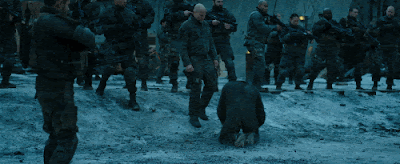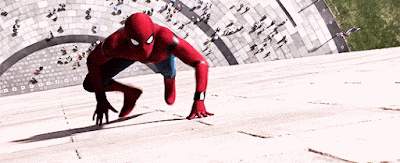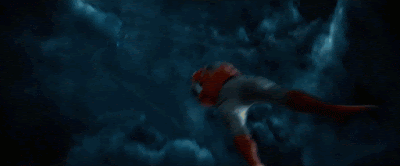One of the things missing in most modern movies these days (possibly because audiences might find it "corny") is "the sing-along," where a group of characters participate in a collective musical performance that shows they can work together as a group to a common purpose. Corny? Maybe. But it's a great audio-visual short-hand for communicating a dramatic idea—the resolving of differences. Just as an orchestra can combine rhythm, brass, and strings to a unified whole, so, too, can disparate personalities and talents come together to create a sum greater than the parts. We see this work in music groups all the time, and there's no more obvious example in the movies than the Beatles documentary Let It Be, where the four writer-musicians bicker and back-bite, but manage to put it all together in their final concert on the Apple Studio roof-top, a meshing performance that shows just how good they could be.
This month, in our "Don't Make a Scene" section, we'll present four sing-alongs from movies that display dramatically, through music, the putting-aside of differences in the creation of a unified effort—harmony. And as music is the important element here, and really doesn't work one note at a time, we will temporarily dispense with the usual frame-by-frame breakdowns, and present the scenes in their full 24 frames per second vitality. Here, we deviate slightly from that formula; there is no singing involved, but—for a very short idyll—there is harmony.
This is the very famous scene from the admittedly near-perfect adaptation of James Dickey's novel, Deliverance, that John Boorman crafted in 1972. That this is the film's most played scene and most familiar is probably due to it being one of the few parts of it that doesn't need to be censored in some way.
It is also the emotional high-point; the rest of the film is all down-stream from here. It comes quite early on, once the four middle-class adventurers reach their first intended stop at a filling station to get drivers to take their trucks down-river. There is immediate animosity between the locals and the tourists, abated only briefly by the duet that makes up the heart of the scene.
Even that is a far cry from convivial—the piece is called "Dueling Banjos" (adapted from the 1955 piece "Feudin' Banjos" created by Arthur Smith and Don Reno, but not credited to them, which resulted in a copyright infringement case) and implies a contest, a competition, two players at odds. Even the title invokes conflict.
The banjo player was portrayed (at the age of 16) by Billy Redden, who still lives in the locale of the film's filming, Rabun County Georgia, where he runs a cafe. He will occasionally do cameo's in films—like Tim Burton's Big Fish, playing essentially the same role. He can play a bit of banjo now, but at the time, he was just faking it, the playing being done is by a hidden musician with his arms sticking out from Redden's shirt.
It is a momentary lapse of hostilities between cultures...that will never be repeated throughout the rest of the film.
It is also the emotional high-point; the rest of the film is all down-stream from here. It comes quite early on, once the four middle-class adventurers reach their first intended stop at a filling station to get drivers to take their trucks down-river. There is immediate animosity between the locals and the tourists, abated only briefly by the duet that makes up the heart of the scene.
Even that is a far cry from convivial—the piece is called "Dueling Banjos" (adapted from the 1955 piece "Feudin' Banjos" created by Arthur Smith and Don Reno, but not credited to them, which resulted in a copyright infringement case) and implies a contest, a competition, two players at odds. Even the title invokes conflict.
The banjo player was portrayed (at the age of 16) by Billy Redden, who still lives in the locale of the film's filming, Rabun County Georgia, where he runs a cafe. He will occasionally do cameo's in films—like Tim Burton's Big Fish, playing essentially the same role. He can play a bit of banjo now, but at the time, he was just faking it, the playing being done is by a hidden musician with his arms sticking out from Redden's shirt.
It is a momentary lapse of hostilities between cultures...that will never be repeated throughout the rest of the film.
The Set-Up: Four good ol' suburban Southern boys (Jon Voight and Burt Reynolds, as well as Ned Beatty and Ronny Cox in their film debuts) decide to take a weekend adventure canoeing down a river that will soon disappear due to the construction of a dam nearby. The area will become flooded, the Cahulawassee River lost in the reservoir the dam will create. At the urging of Lewis Medlock (Reynolds) the four drive up into the Georgia hills to the head of the river, hoping to contract drivers to take their trucks to the end of the rapids of their return home. As this scene opens, they have stopped to gas up and attempt to get the help they need, but maybe not the attention they want.
1-2-3...
Words by James Dickey (and John Boorman)
Pictures by Vilmos Zsigmond and John Boorman
Deliverance is available on DVD and Blu_Ray from Warners Home Video.


















































